|
General William T. Sherman's March to the Sea -- His Campaign of the Carolinas, aka Carolinas Campaign -- Civil
War History
Sherman's March to the Sea and Campaign of the Carolinas
| Campaign of the Carolinas |
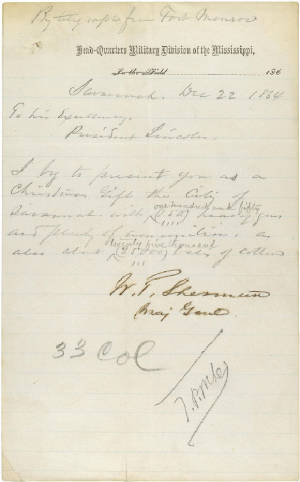
|
| Carolina Campaign |
(Right) Letter from General Sherman to President Lincoln. En route (from
Sherman's March to the Sea) to the Campaign of the Carolinas, Gen. Sherman stated, in this letter, that Savannah,
Georgia, was his present and "Christmas gift" to the president. Savannah, Dec. 22, 1864, W. T. Sherman
The 300-mile (480 km) march began on November 15, 1864. Sherman recounted
in his memoirs the scene when he left at 7 a.m. the following day:
... We rode out of Atlanta by
the Decatur road, filled by the marching troops and wagons of the Fourteenth Corps; and reaching the hill, just outside
of the old rebel works, we naturally paused to look back upon the scenes of our past battles. We stood upon the very ground
whereon was fought the bloody battle of July 22d, and could see the copse of wood where McPherson fell. Behind us lay Atlanta,
smouldering and in ruins, the black smoke rising high in air, and hanging like a pall over the ruined city. Away off in the
distance, on the McDonough road, was the rear of Howard's column, the gun-barrels glistening in the sun, the white-topped
wagons stretching away to the south; and right before us the Fourteenth Corps, marching steadily and rapidly, with a cheery
look and swinging pace, that made light of the thousand miles that lay between us and Richmond. Some band, by accident, struck
up the anthem of "John Brown's soul goes marching on;" the men caught up the strain, and never before or since have I heard
the chorus of "Glory, glory, hallelujah!" done with more spirit, or in better harmony of time and place. –
William T. Sherman, Memoirs of General W.T. Sherman, Chapter 21
After his controversial march from Atlanta to Savannah, Sherman turned
his army of 60,000 north. In March 1865 he entered North Carolina. Living off the land and destroying public buildings and
factories, the Union commander brought his "total war" policy to a state that had been slow to secede. Johnston, recently
placed in command of the Confederate Army of Tennessee, failed to stop Sherman at the Battle of Bentonville.
| Campaign of the Carolinas Map |
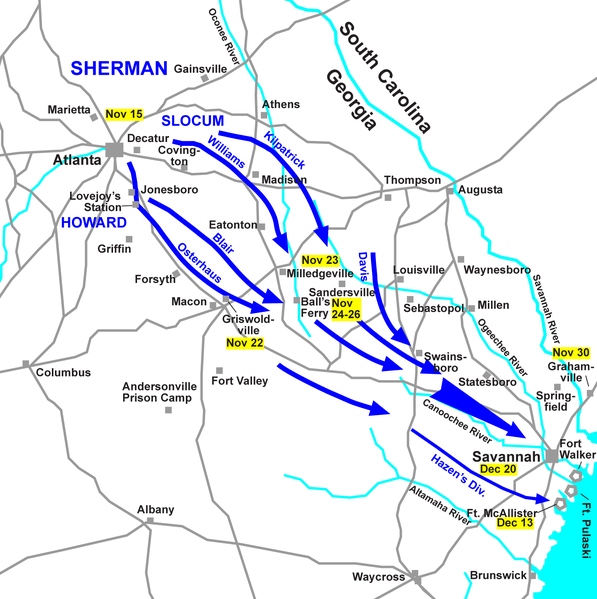
|
| (Sherman's March to the Sea Map) |
After Sherman captured Savannah, the culmination of his march to the sea,
he was ordered by Union Army general-in-chief Lt. Gen. Ulysses S. Grant to embark his army on ships to reinforce the Army
of the Potomac and the Army of the James in Virginia, where Grant was bogged down in the Siege of Petersburg against Confederate General Robert E. Lee. Sherman, however, had
a grander plan in mind. He predicted on January 5, 1865: "I do think that in the several grand epochs of this war, my name
will have a prominent part." He persuaded Grant that he should march north through the Carolinas instead (See Campaign of the Carolinas), destroying everything of military value along the way, similar to his march to the
sea through Georgia. Sherman was particularly interested in targeting South Carolina, the first state to secede from the Union,
for the effect it would have on Southern morale. (See also: Georgia Civil War History and South Carolina Civil War History.)
| Campaign of the Carolinas Civil War Map |
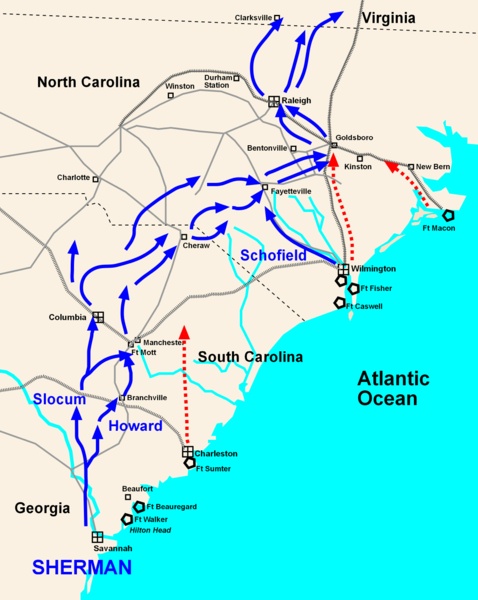
|
| Carolinas Campaign Map of Union and Confederate Armies with Movements |
Sherman's army commenced toward Columbia,
South Carolina, in late January 1865. His 60,079 men were divided into three wings: the Army of the Tennessee, under Maj.
Gen. Oliver O. Howard, the Army of the Ohio under Maj. Gen. John M. Schofield, and two corps, the XIV and XX, under Maj. Gen.
Henry W. Slocum, which was later formally designated the Army of Georgia. Reinforcements arrived regularly during his march
north, and, by April 1, he commanded 88,948 men.
| Campaign of the Carolinas Civil War Map |
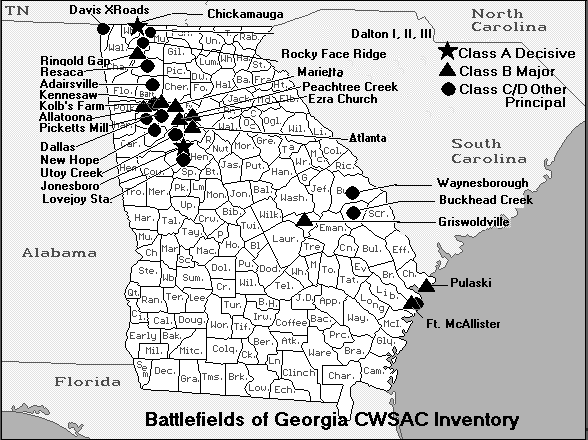
|
| (Map of Civil War Georgia) |
| Atlanta Campaign Map |
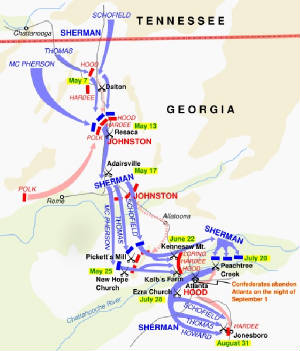
|
| (Civil War Georgia Map) |
| Sherman's Carolina Campaign |
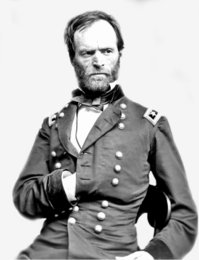
|
| Campaign of the Carolinas |
The Confederate army, moreover, was considerably smaller. The
primary force in the Carolinas was the battered Army of Tennessee, again under the command of General Joseph E. Johnston (who
had been relieved of duty by Confederate President Jefferson Davis during the Atlanta Campaign against Sherman). His strength
was recorded in mid-March at 9,513 and 15,188 by mid-April. The army was organized into three corps, commanded by Lt. Gen.
William J. Hardee, Lt. Gen. Alexander P. Stewart, and Lt. Gen. Stephen D. Lee. Also in the Carolinas were cavalry forces from
the division of Maj. Gen. Wade Hampton and a small number in Wilmington under Gen. Braxton Bragg.
| Sherman and the March to the Sea Map |
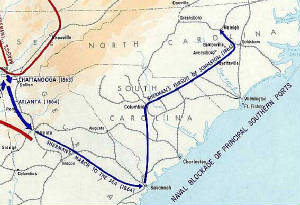
|
| (Campaign of the Carolinas Map) |
| Sherman's March and the Carolina Campaign Map |
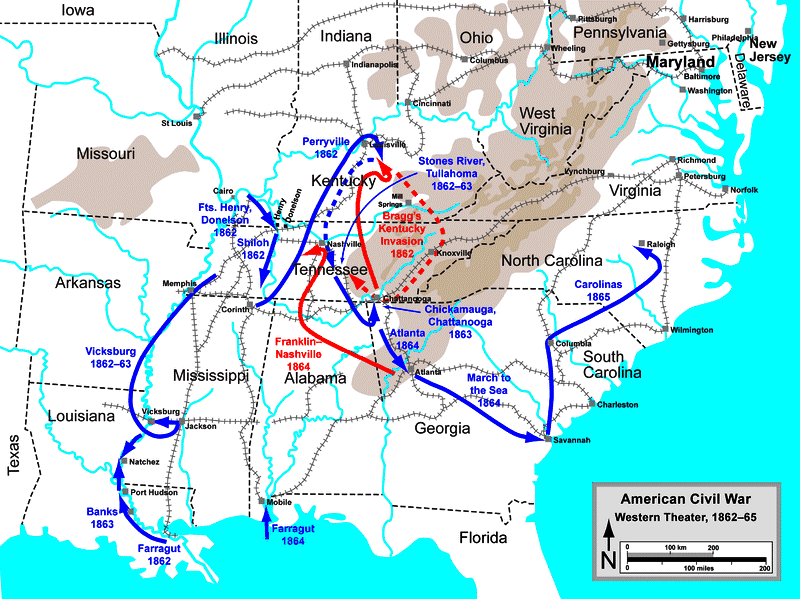
|
| (Western Theater of the Civil War Map) |
Sherman's plan was to bypass the minor Confederate troop concentrations
at Augusta, Georgia, and Charleston, South Carolina, and reach Goldsboro, North Carolina, by March 15. As with his Georgia
operations, Sherman marched his armies in multiple directions simultaneously, confusing the scattered Confederate defenders
as to his first true objective, which was the state capital of Columbia.
| Sherman's March to the Sea Map |
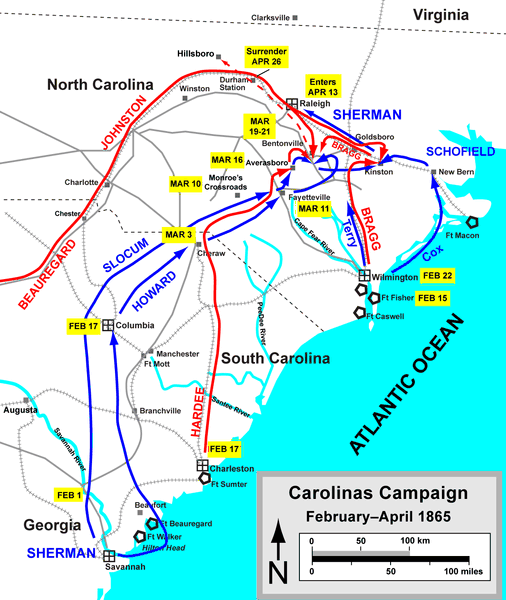
|
| Map of Union and Confederate Civil War Battles |
Sherman's Carolina Campaign (See Campaign of the Carolinas), in which his troops marched 425 miles (684 km) in 50 days, had been similar
to his march to the sea through Georgia, although physically more demanding. However, the Confederate forces opposing him
were much smaller and more dispirited. When Joseph E. Johnston met with Jefferson Davis in Greensboro in mid-April, he told
the Confederate president:
"Our people are tired of the war, feel themselves whipped, and will not
fight. Our country is overrun, its military resources greatly diminished, while the enemy's military power and resources were
never greater and may be increased to any extent desired. ... My small force is melting away like snow before the sun."
| North Carolina Campaign Map |

|
| (North Carolina Civil War Map) |
| South Carolina Campaign Map |
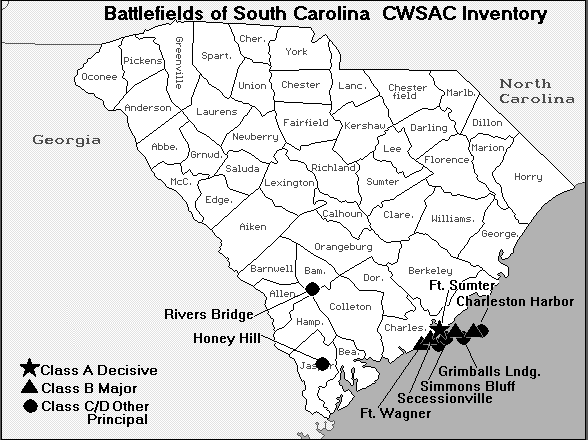
|
| (Carolina Campaign Map) |
| Civil War Carolina Campaign History |
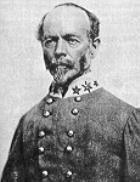
|
| Campaign of the Carolinas |
On April 18, three days after the death of President Abraham Lincoln,
Johnston signed an armistice with Sherman at Bennett Place, a farmhouse near Durham Station. Sherman got himself into political
hot water by offering terms of surrender to Johnston that encompassed political issues as well as military, without authorization
from General Grant or the United States government. The confusion on this issue lasted until April 26, when Johnston agreed
to purely military terms and formally surrendered his army and all Confederate forces
in the Carolinas, Georgia, and Florida. It was the second significant surrender that month; on April 9, Robert E. Lee had
surrendered the Army of Northern Virginia at Appomattox Court House. It was the virtual end for the Confederacy, although
some smaller forces held out, or resisted, particularly in the Trans-Mississippi region, into the summer. See also South Carolina Civil War History.
(References and related reading below.)
Recommended Reading: The March to the Sea and Beyond: Sherman's Troops in the Savannah
and Carolinas Campaigns. Description: This book contains an examination
of the army that General William Tecumseh Sherman commanded through Georgia
and the Carolinas, in late 1864 and early 1865. Instead of being just another narrative of
the March to the Sea and Carolina Campaigns, however, Glatthaar's book is a look at the individuals that composed the army.
He examines the social and ideological backgrounds of the men in Sherman's
army, and evaluates how they felt about various factors of the war--slavery, the union, and, most significantly, the campaign
in which they were participating. Continued below…
The result is a fascinating look
at Sherman's
campaigns through the eyes of the everyday soldier. Glatthaar makes the army come alive, and shows the men not as heartless
animals who delighted in wanton destruction, not as mechanized marching machines who could perform the most difficult marches
without even flinching, but instead as real human beings, complete with sore feet, empty stomachs, and minds engaged in contemplation
over the ethical ramifications of what they were doing to the people of the South. This book is a refreshing change from the
norm in Civil War history. The book’s great value is its ability to assist the reader in understanding that the war
was fought by individuals--not masses of blue and gray--and what these individuals felt, thought, and believed during America’s most trying era.
Recommended Reading: Sherman's March: The First Full-Length Narrative of General William T. Sherman's Devastating March through
Georgia and the Carolinas. Description: Sherman's March is the vivid narrative of General William T. Sherman's devastating sweep through
Georgia and the Carolinas in the closing
days of the Civil War. Weaving together hundreds of eyewitness stories, Burke Davis graphically brings to life the dramatic
experiences of the 65,000 Federal troops who plundered their way through the South and those of the anguished -- and often
defiant -- Confederate women and men who sought to protect themselves and their family treasures, usually in vain. Dominating
these events is the general himself -- "Uncle Billy" to his troops, the devil incarnate to the Southerners he encountered.
Recommended Viewing: The History Channel Presents Sherman's March (2007). Description: “The story of General William Tecumseh Sherman who helped
devastate the South's army at the end of the Civil War is told here via vivid reconstructions of his actions.” This
is a great reenactment, presentation. It's not dull like some documentaries that just continually talk with the same guy for
an hour. This includes several individuals that are extremely knowledgeable in their respective fields--be it civilian or
military historian. Continued below...
Also, it includes many re-enactors that portray “Sherman as well as his entire command.” It literally
takes the viewer back to 1864 to experience it firsthand. The viewer will also hear from acclaimed authors and renowned historians
as they address some of the most controversial questions, including: "Who burned Atlanta?" "Was the burning of Atlanta ordered
by Gen. Sherman?" "Were innocent civilians killed by Union soldiers and were homes and building needlessly destroyed?"
Recommended
Reading: Southern Storm: Sherman's March to the Sea, by Noah Andre Trudeau (Hardcover). From Publishers Weekly: Starred
Review. Trudeau, a prize-winning Civil War historian (Gettysburg),
addresses William T. Sherman's march to the sea in the autumn of 1864. Sherman's
inclusion of civilian and commercial property on the list of military objectives was not a harbinger of total war, says Trudeau.
Rather, its purpose was to demonstrate to the Confederacy that there was no place in the South safe from Union troops. Continued
below…
The actual
levels of destruction and pillage were limited even by Civil War standards, Trudeau says; they only seemed shocking to Georgians
previously spared a home invasion on a grand scale. Confederate resistance was limited as well. Trudeau praises Sherman's
generalship, always better at operational than tactical levels. He presents the inner dynamics of one of the finest armies
the U.S. has ever fielded: veteran troops from Massachusetts
to Minnesota, under proven officers, consistently able to
make the difficult seem routine. And Trudeau acknowledges the often-overlooked contributions of the slaves who provided their
liberators invaluable information and labor. The march to the sea was in many ways the day of jubilo, and in Trudeau it has
found its Xenophon. 16 pages of b&w photos, 36 maps.
Recommended
Reading: Sherman's March Through the Carolinas. Description: In retrospect, General William Tecumseh Sherman considered his march
through the Carolinas the greatest of his military feats, greater even than the Georgia
campaign. When he set out northward from Savannah with 60,000
veteran soldiers in January 1865, he was more convinced than ever that the bold application of his ideas of total war could
speedily end the conflict. Continued below…
John Barrett's
story of what happened in the three months that followed is based on printed memoirs and documentary records of those who
fought and of the civilians who lived in the path of Sherman's onslaught. The burning of Columbia, the battle
of Bentonville, and Joseph E. Johnston's surrender nine days after Appomattox are at the center of the story, but Barrett
also focuses on other aspects of the campaign, such as the undisciplined pillaging of the 'bummers,' and on its effects on
local populations. About the Author: John G. Barrett is professor emeritus of history at the Virginia Military Institute.
He is author of several books, including The Civil War in North Carolina,
and coeditor of North Carolina Civil War Documentary.
Recommended Reading: Bentonville: The Final Battle of Sherman and Johnston (Civil War America). From Booklist: In March 1865, the Confederacy was dying, and Sherman's army was marching into North Carolina.
Joseph Johnston made one last, desperate effort to halt the advance of an army three times the size of his, and on March 19
surprised one wing of Sherman's forces. Continued below...
A single Union corps very nearly won the battle all by itself, however, and when reinforced, drove off the
attackers, inflicting heavy casualties. Hughes' excellent battle monograph is oriented toward the scholarly reader but accessible
to the general one. Its particular strengths include verbal portraits of many leaders on both sides and eloquently understated
descriptions of whole Confederate brigades going into battle with barely the rifle strength of a healthy company. A desirable
addition to Civil War literature. Includes 9 maps.
References: Eicher, David J., The Longest Night: A Military History of the
Civil War, Simon & Schuster, 2001; North Carolina Office of Archives and History; Official Records of the Union and Confederate
Armies; General William T. Sherman Memoirs.
|

